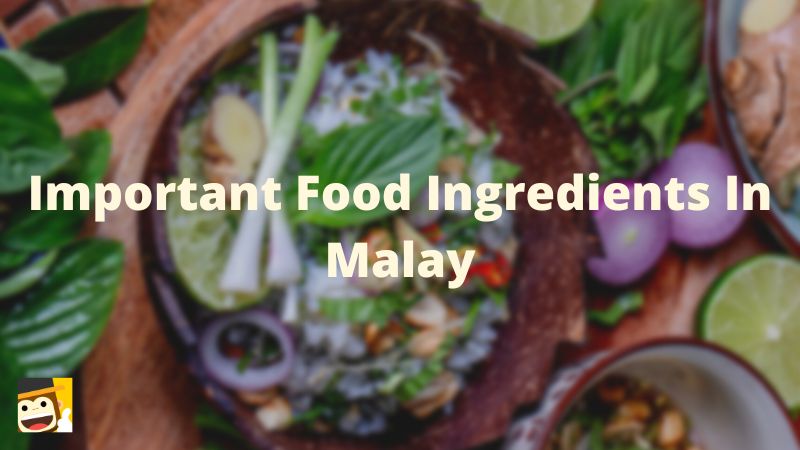If you’ve ever tried Malay food, then you know that it’s something special. In fact, arguably, Asian countries have some of the best food, from Chinese food to Indian food. But, knowing what’s actually in your food will allow you to appreciate the dish even more than before. That’s why you should learn Malay and 70+ great food terms in Malay!
The next time you visit a food stall to order your favorite noodle dish, chicken curry, or grilled chicken, wouldn’t you love to be able to communicate with the merchant? Once you learn this vocabulary about food/food ingredients in Malay, order will be a breeze! Who knows, maybe the merchant will even ask you to be their assistant!
We have 70+ excellent food vocabulary terms and ingredients to teach you, but before all that, let’s go over a couple of common misconceptions and some key features of Malay food!
Where Is Malay Cuisine Served?
This is a commonly asked question regarding Malay cuisine, so let’s clear up any confusion and misconceptions now! Below is a list of the places where you can find Malay cuisine served:
- Southern Thailand
- Malaysia
- Singapore
- Indonesia
- Brunei
- Philippines
- Sri Lanka
- South Africa
- Cocos Island (external territory of Australia)
- Christmas Island (external territory of Australia)
As you can see from our list, Malay cuisine can be found in many other Asian countries! However, for the purpose of this blog post, we’ll be referring to the common Malay dishes found in Malaysia, specifically peninsular Malaysia.
Where Is Malaysia?
Malaysia is a Southeast Asian country that borders Thailand, Singapore, Brunei, and Indonesia.
The country has a bustling capital city, known as Kuala Lumpur, and a population of over 32 million people.
The official language of Malaysia is Malaysian, which is a standard form of the Malay language.
Key Features Of Malay Food

Now that you have a little background on Malay cuisine and Malaysia, let’s start talking about the most exciting part – the food!
Every country prepares and cooks its food in different ways. Some countries might bake most of their dishes, while another country grills theirs over a fire! Different countries also use different ingredients, depending on the weather in that particular country and the long-standing cooking traditions.
Preparing food in Malaysia is characterized by lots and lots of spices! So, please make sure that if you aren’t a fan of spicy food or can’t handle spicy food, you should ask the merchant to lower the spice level when you order!
In addition to spices, Malaysian dishes often use coconut milk (santan), shrimp paste (belacan), lemongrass (serai), galangal (lengkuas), and, of course, steamed rice (nasi). These ingredients are all staples of Malaysian food culture and they are what make Malaysian cuisine and Malay dishes so delicious.
Not to mention, the more traditional food, particularly Malay desserts, are just as delicious. When it comes to local cooking, once you take one bite, you won’t be able to stop eating!
Food Terms In Malay To Know

It’s time to take a look at food terms in Malay you must know!
- ais kachang – shaved ice
- apam balik – peanut pancake
- asam pedas – sour and spicy fish stew
- ayam percik – spicy roasted chicken
- bak kut teh – pork ribs in broth
- bubur– Rice porridge
- cendawan goreng – crispy mushroom
- char kuey teow – fried flat noodles
- hokkien char mee – stir fried noodles
- ikan bakar – charcoal grilled fish
- ketupat– rice cake packed inside a palm leaf
- kuih -bite sized desserts or snacks
- laksa – spicy noodle soup
- mee goreng mamak – mamak style stir fried noodles
- murtabak – spicy folded omelet pancake
- nasi goreng kampung – fried rice
- nasi kandar– steamed rice usually served with a variety of curries or sides
- nasi kerabu – butterfly pea rice served with fried chicken or dried fish
- nasi lemak – coconut rice usually served with a variety of sides
- popia basah – fresh spring rolls
- Rendang-caramelized meat
- Roti canai – deep fried dough
- sambal udang – prawns in chili paste
- satay – seasoned, skewered and grilled meat
- wonton mee – wonton noodle soup
- yong tau foo– fish and/or meat paste stuffed in tofu
- you char kuay – Chinese doughnut
Now that you’ve learned some food vocabulary terms, let’s move on to important food ingredients in Malay. By the way, are you getting hungry yet?
Important Food Ingredients In Malay

Here are the most important food ingredients to remember in Malay!
- Bamboo shoots – rebung
- Banana leaves – daun pisang
- Bean sprouts – taugeh
- Beef – daging lembu
- Boiled egg – telur rebus
- Chicken – ayam
- Chili – cili api
- Chili paste – pes cili
- Chili sauce – sos cili
- Cilantro – ketumbar
- Cinnamon sticks – batang kayu manis
- Cloves – bunga cengkih
- Coconut cream – krim kelapa
- Coconut milk – santan
- Cucumber – timun
- Dried fish – ikan kering
- Dried shrimp – udang kering
- Egg – telur
- Fish – ikan
- Fish sauce – sos ikan
- Galangal – lengkuas
- Garlic – bawang putih
- Ginger – halia
- Glutinous rice/Sticky rice – nasi pulut
- Green onions – bawang hijau
- Hot sauce – sos panas
- Kaffir lime – limau purut
- Lemongrass – serai
- Lime juice – jus limau
- Minced meat – daging cincang
- Nutmeg – buah pala
- Onion – bawang besar
- Oyster sauce – sos tiram
- Palm sugar – gula melaka
- Pork – daging babi
- Pandan leaves – daun pandan
- Raw egg – telur mentah
- Rice flour – tepung beras
- Sesame seeds – bijan
- Shallot – bawang merah
- Shrimp – udang
- Shrimp paste – belacan
- Soy sauce – sos soya
- Star anise – bunga lawang
- Steamed rice – nasi kukus
- Squid – sotong
- Tamarind – asam jawa
- Tamarind juice – air asam jawa
- Turmeric powder – serbuk kunyit
- Vermicelli noodles – mee bihun
- White rice – nasi putih
- Yellow noodles – mee kuning
Now that you’ve learned 70+ food terms in Malay, it’s time that you go out and practice these with the next merchant you come across!
Still Craving To Learn More Malay?

Have all these food vocabulary terms, and food ingredients made you want to learn more about Malay? If so, we have the perfect app to satisfy your craving!
The Ling App is a language learning app specifically designed to teach you a new language in the most effective way possible. Find out some key features of the app below:
- Daily lessons that make learning engaging
- Relevant vocabulary that can be used in real-life conversations
- Ability to practice writing in real-time
- Instant feedback on your pronunciation via an interactive AI chatbot
- Friendly customer support team available if you have any issues
- Available in the App Store, Google Play, and desktop version
These are just a few of the great features that Ling offers. If you want to learn more about a specific language, you can always go to Ling’s free language blog for additional resources. For example, Ling has some great posts on Malaysian culture.
Whether you want to continue learning about the beautiful Malay language or start learning a new language altogether – Ling can help you get there!








































